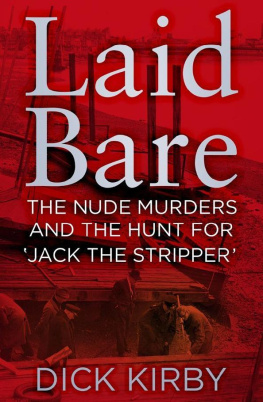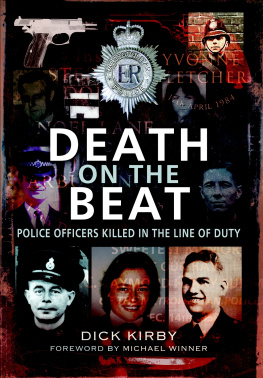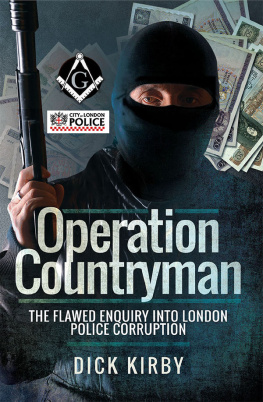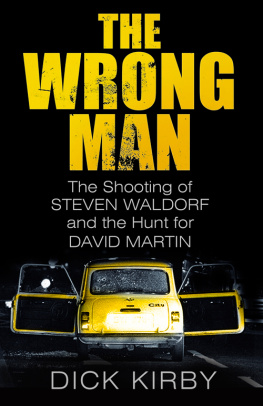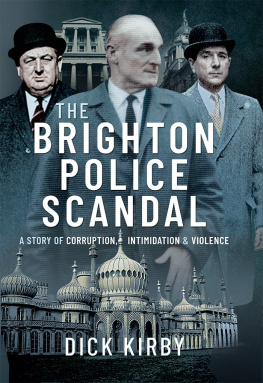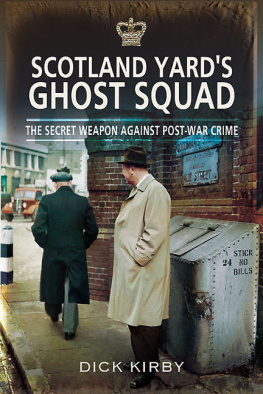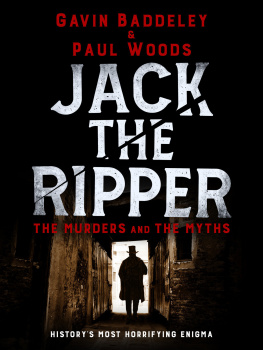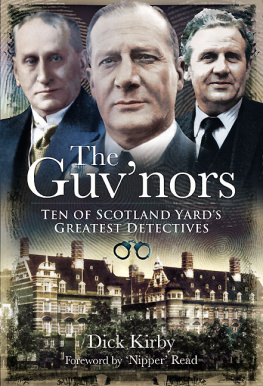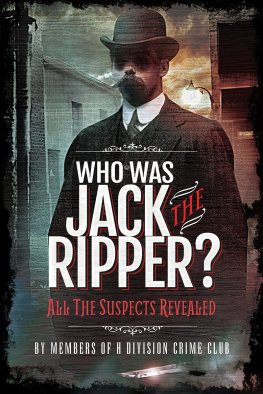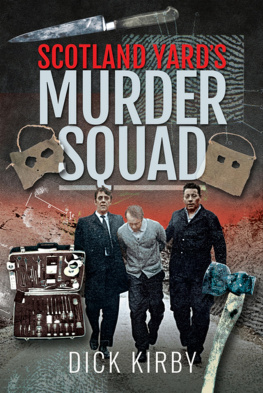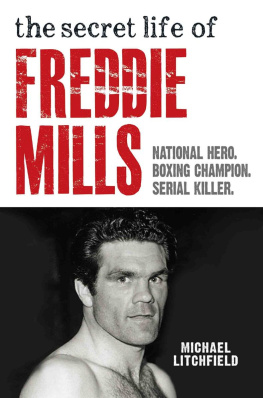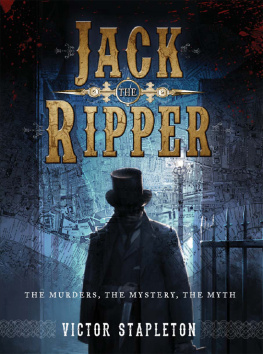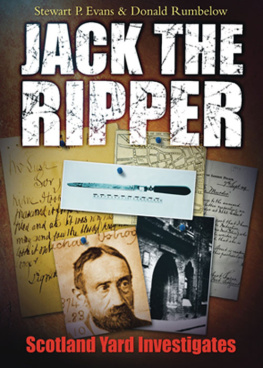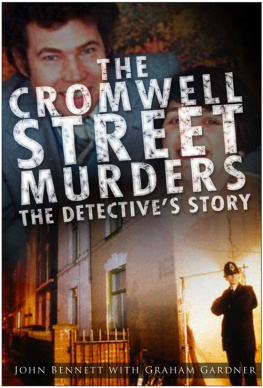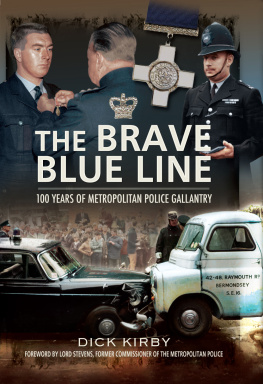
Dick Kirby has also written:
Rough Justice Memoirs of a Flying Squad Detective
The Real Sweeney
Youre Nicked!
Villains
The Guvnors: Ten of Scotland Yards Greatest Detectives
The Sweeney: The First Sixty Years of Scotland Yards Crimebusting
Flying Squad 19191978
Scotland Yards Ghost Squad: The Secret Weapon Against Post-War Crime
The Brave Blue Line: 100 Years of Metropolitan Police Gallantry
Death on the Beat: Police Officers Killed in the Line of Duty
The Scourge of Soho: The Controversial Career of SAS Hero Detective Sergeant Harry Challenor, MM
Whitechapels Sherlock Holmes: The Casebook of Fred Wensley, OBE, KPM Victorian Crimebuster
The Wrong Man: The Shooting of Steven Waldorf and
The Hunt for David Martin

This book is dedicated to my chum, Bill Maclaurin.
His link with dubious company led to a flow of indispensable information.
And, of course, to Ann: till the stars grow cold
First published in 2016
The History Press
The Mill, Brimscombe Port
Stroud, Gloucestershire, GL5 2QG
www.thehistorypress.co.uk
This ebook edition first published in 2016
All rights reserved
Dick Kirby, 2016
The right of Dick Kirby to be identified as the Author of this work has been asserted in accordance with the Copyright, Designs and Patents Act 1988.
This ebook is copyright material and must not be copied, reproduced, transferred, distributed, leased, licensed or publicly performed or used in any way except as specifically permitted in writing by the publishers, as allowed under the terms and conditions under which it was purchased or as strictly permitted by applicable copyright law. Any unauthorised distribution or use of this text may be a direct infringement of the authors and publishers rights, and those responsible may be liable in law accordingly.
EPUB ISBN 978 0 7509 6938 3
Original typesetting by The History Press
eBook converted by Geethik Technologies
CONTENTS
ACKNOWLEDGEMENTS
F irst, I should like to pay tribute to my friend of twenty-plus years Alan Moss for his splendid foreword to this book; a fellow author and a former chief superintendent in the Metropolitan Police, Alan is a well-respected historian. I also wish to thank Mark Beynon, the Commissioning Editor of The History Press, for allowing him to bully me into writing this book. Im glad he did; it has been a fascinating experience.
I wish to particularly thank John G.D. Grieve, CBE, QPM, BA (Hons), MPhil, Professor Emeritus; and Dr Peter Jerreat, MB, BS, B.Sc., DMJ (Path), Emeritus Home Office pathologist, for their very kind and thoughtful inputs to the book.
Next, Phillip Barnes-Warden, Metropolitan Police; Linda Bailey and Beverley Edwards, chairman of the Metropolitan Women Police Association; Bob Fenton, QGM, honorary secretary of the Ex-CID Officers Association; Susi Rogol, editor of the London Police Pensioner Magazine; Barry Walsh, Friends of the Metropolitan Police Historical Collection; and Emily Burnell, senior pensions administrator, Equiniti Pension Solutions, all of whom were very helpful. Special thanks to my fellow author and friend, Stewart Evans, and his wife, Rosemarie, for their hospitality and assistance in researching this book.
There were a number of people I approached who, for reasons best known to themselves, refused to respond to my requests for information. There were others who did so but asked me to respect their request not to be named and, of course, I have done so. And there were a small minority who provided pertinent assistance completely anonymously. Whoever you are, please accept my thanks.
Others who were not so shy appear in alphabetical order: Terry Babbidge, QPM; Brian Baister, QPM, MA; Robert Bartlett; Rod Bellis; Ken Bowerman, GM; Keith Buxton; Geoff Cameron; Janet Cheal; Bob Cook; John Cox; Roger Crowhurst; Mo Darroch; Kevin Gainford; Bob Hayday; Alan Jackaman; Bryan Martin; Jeannette McGeorge; Paul Millen; Michael Nadin; Michael Nesbitt; Barry Newman; John Newman; Gerry ODonoghue; David Parkinson; Albert Patrick; the late Arthur Phillips; David Pritchard; Peter Quested; Leonard Nipper Read, QPM; Bob Roach; Jane Rogers; John Strachan; Peter Westacott; David Woodland and Keith Yeulett.
Photos were supplied by Ken Bowerman GM, David Weir, David Woodland and from the authors own collection, and whilst every effort has been made to trace copyright holders, if there are any errors or omissions, The History Press will be glad to insert the appropriate acknowledgement in any subsequent printings or editions.
My thanks, as always, to my son-in-law, Steve Cowper, for guiding me through the minefield of cyber-land and my love and admiration goes to my children, Suzanne, Mark, Robert and Barbara, and to their children, Emma Cowper, B.Mus., Jessica Cowper, B.Mus., Harry Cowper and Samuel and Annie Grace Jerreat.
Most of all, my love to my wife Ann; together we escorted each other from the grip of that pernicious disease, cancer.
Dick Kirby, Suffolk, 2016
FOREWORD
T he Nude Murders that occurred near Dukes Meadows and the Heron Trading Estate in 196465 have all the hallmarks of the classic murder mysteries that have kept authors and journalists busy for many years, but they have never before received the authoritative analysis and style of attention given to them by this book. They were as serious as the Whitechapel Murders of 188889 by Jack the Ripper and they shared many characteristics. They involved prostitutes and remained unsolved, despite many police resources being sent to the area. They engendered much speculation, by newspapers and others, about potential suspects, including well-known people or even a police officer. There were indirect connections to the concerns of the government, in this case the Profumo scandal. The Nude Murders have not generated books and TV programmes on the industrial scale given to the Whitechapel Murders, but that is not because they were any less noteworthy or intriguing.
Seventy-six years after the Whitechapel murders the police had the advantage of fingerprint technology and many forensic science techniques unknown to their Victorian counterparts, but the Nude Murders nevertheless remain unsolved. The perpetrator disposed of his victims bodies in a far more calculating fashion than Jack the Ripper. The investigation teams made heroic efforts, and spent countless hours and days searching for and cross-referencing information, necessarily using methods that todays computers would make redundant, if not laughable in some respects. Reputations were at stake in the Metropolitan Police. The world of prostitutes and their unsavoury clients is not something that is generally well known, even within most parts of the police, but the investigation made commendable efforts to work alongside this murky world of vice in order to catch the one crucial insight that might have led to the offender. Luck was not on the side of the police in this case.
Any police officer likes to know the inside story of who really did what, and many of us, especially when retired, like to air our insights into the mysteries that have covered the pages of the newspapers. Because the investigations are still within the living memory of some of the surviving officers from the team, this book, unusually, tells us what some of them thought about the case, and how they regarded the officers in charge of the investigation. We know some of the funny stories that occurred in those dark streets late at night. We can read about the enormous effort that was put in by teams of forensic scientists and how the mysterious marks on the victims bodies were painstakingly traced to a specific location on a trading estate. We know the lines of enquiry that were followed, and can even consider the arguments about whether the cause of death was connected to the sex act that may have taken place. We know what the author thinks of people.
Next page
